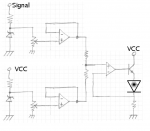- Joined
- Jul 6, 2016
- Messages
- 6
- Points
- 0
I am interested in building a diode based laser with power throttling capabilities. I am interested in building one with a maximum power of 500mw or 1000mw maximum power, but I would also like to use the same laser at lower power. One practical benefit of throttling a laser is that I can adjust focusing and alignment with the laser at lower/safer power. I can also test for unexpected reflections at low power. I would like the laser to have 2 or 3 different buttons, so that I can change between power levels in an instant. Has anyone here heard of a laser driver with this sort of capabilities?
I am also thinking that I could design and build the driver myself, if there are no throttling drivers on the market. I do not need the device to fit in a small space, a larger device is acceptable. I do have electronics experience similar to an associates degree. It's been many years, so I may have to brush up, but I know there are ways to combine power transistors and operational amplifiers to act as current and voltage regulators.
If I design the driver myself, I see two different ways to throttle the power. I could simply have a current regulator with multiple settings. The disadvantage to this method is, I must get above the threshold current. Operating at a few percent of maximum power is difficult/impossible for some laser diodes. Another method of throttling a laser I would imagine, is to rapidaly pulse it. I could design the driver to create a series of 500ns laser pulses and alter the time between pulses to create a short duty cycle of 3% or less.
What do you think?
I am also thinking that I could design and build the driver myself, if there are no throttling drivers on the market. I do not need the device to fit in a small space, a larger device is acceptable. I do have electronics experience similar to an associates degree. It's been many years, so I may have to brush up, but I know there are ways to combine power transistors and operational amplifiers to act as current and voltage regulators.
If I design the driver myself, I see two different ways to throttle the power. I could simply have a current regulator with multiple settings. The disadvantage to this method is, I must get above the threshold current. Operating at a few percent of maximum power is difficult/impossible for some laser diodes. Another method of throttling a laser I would imagine, is to rapidaly pulse it. I could design the driver to create a series of 500ns laser pulses and alter the time between pulses to create a short duty cycle of 3% or less.
What do you think?






